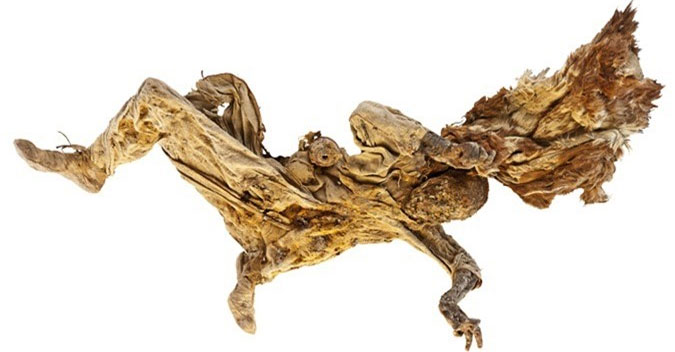The cave salt preserved the body of the whole person 2,200 years
For 6 years of searching, a total of 4 mummies were found in this salt cave.
Salt caves are located in northwestern Iran, near the villages of Hamzehli, Mehrabad and Chehrabad, Zanjan province. It is a large salt cave, consisting of a variety of salty rocks, gypsum, clay and rock salt, formed during the Miocene period (5 to 23 million years ago).
There are many salt mines located in the southeast of this cave. Many of them appeared from ancient times. During one underground salt mining in 1994, miners discovered a human head. Although this body part dates back to prehistoric times, however, it is the dry salt here that preserves it perfectly, to the point that even golden earrings keep the same color. In addition, the hair and mustache of the head was not divided.

The heads and feet are found in the salt cave.(Photo: Ensie & Matthias).
After excavating the area deeper in the hope of finding enough bodies, archaeologists discovered one more leg of intact leather shoes. Besides, there are 3 iron knives, a set of woolen clothes, a silver needle, a rope, a piece of leather, grindstone, walnut, some pieces of ceramic, a woven cloth and some broken bones.
In 2004, archaeologists continued to discover another body there. At this point, they officially conducted a large-scale excavation. For the next 6 years, a total of 4 'salt people' were found.
All 'saltmen' date to about 2,200 years ago, the reign of the first Persian Empire, Achaemenids. The researchers suspect, all the mummies are victims of this salt mine itself.

The most complete mummy excavated by archaeologists.(Photo: Ensie & Matthias).
Thanks to the well-preserved mummies and utensils, scientists are much easier to conduct research. Typically, they discovered a mummy inside a parasite tapeworm eggs, indicating that this person used to eat raw meat. This is considered the first case of intestinal parasites detected in ancient Iran as well as in the region. Besides, the scientists also found that on the eye socket of this person has a crack, proving that before death each suffered a strong punch.
Currently mummies are on display at the Iranian National Museum in Tehran.
- The undersea city was built from a 250 million year salt mine
- Strange cave with salt cured
- Why should not eat too salty?
- Little things to know about salt
- Eating too little salt is also harmful to health
- The mystery of mummies of
- Ma's hidden mystery and ancient coffins
- 57 newly discovered caves in Quang Binh
- Detecting salt mummies from 1,800 years ago
- Video: Salt helps the Egyptian mummy survive for thousands of years
- Detected the double lion's body 12,000 years intact
- The secret to mummification is unique in the Philippines
 Discovered an ancient centipede fossil 99 million years old
Discovered an ancient centipede fossil 99 million years old Discovered bat-like dinosaurs in China
Discovered bat-like dinosaurs in China Discovered a 200-year-old bronze cannon of the coast
Discovered a 200-year-old bronze cannon of the coast Discover 305 million-year-old spider fossils
Discover 305 million-year-old spider fossils